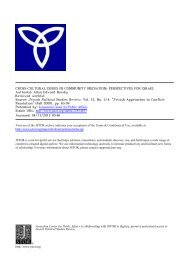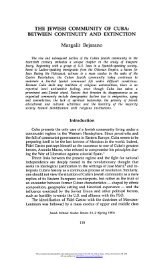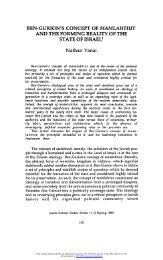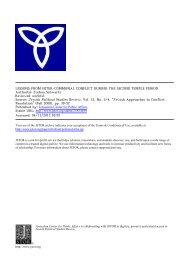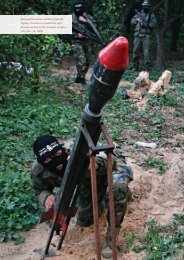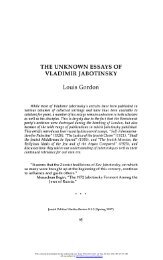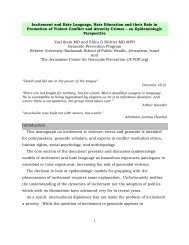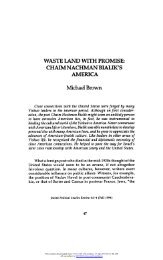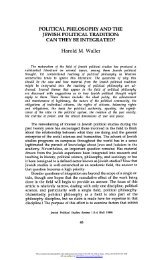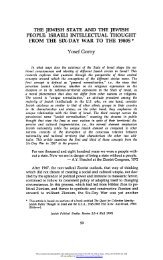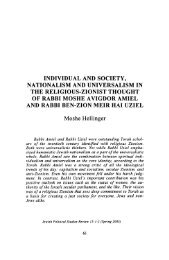Linking the Gaza Strip with the West Bank: - Jerusalem Center For ...
Linking the Gaza Strip with the West Bank: - Jerusalem Center For ...
Linking the Gaza Strip with the West Bank: - Jerusalem Center For ...
You also want an ePaper? Increase the reach of your titles
YUMPU automatically turns print PDFs into web optimized ePapers that Google loves.
There were three phases to <strong>the</strong> Roadmap. In each phase<strong>the</strong> parties were expected to perform <strong>the</strong>ir obligationsin parallel, unless o<strong>the</strong>rwise stated. Progress under <strong>the</strong>Roadmap required and depended upon <strong>the</strong> good fai<strong>the</strong>fforts of <strong>the</strong> parties and <strong>the</strong>ir compliance <strong>with</strong> each of<strong>the</strong>ir obligations. Phase I of <strong>the</strong> Roadmap was directedat ending terror and violence, normalizing Palestinianlife, and building Palestinian institutions. Phase II wasa transition phase, wherein efforts were to be focusedon creating an independent Palestinian State <strong>with</strong>provisional borders and attributes of sovereignty, basedon a new constitution, as a step towards a permanentstatus settlement. As part of this process, <strong>the</strong>re wasto be implementation of prior agreements to enhancemaximum territorial contiguity. This suggests thatprovisions of safe passage in prior agreements were tobe implemented in Phase II of <strong>the</strong> Roadmap. Finally,Phase III dealt <strong>with</strong> a Permanent Status Agreement and<strong>the</strong> End of <strong>the</strong> Israeli Palestinian Conflict.obligations. 132 Similar sentiments were expressedby Ariel Sharon in September 2005, when he said that“[t]he State of Israel is committed to <strong>the</strong> Roadmap.” 133Fur<strong>the</strong>r, none of <strong>the</strong> parties involved have renounced,ei<strong>the</strong>r expressly or tacitly, <strong>the</strong> provisions of <strong>the</strong> Roadmapor <strong>the</strong> Roadmap in its entirety.The General Outline of Sharon’s Disengagement Planwas made public in April 2004. The main aspects of thisplan were <strong>the</strong> evacuation of <strong>the</strong> <strong>Gaza</strong> <strong>Strip</strong>, including allexisting Israeli towns and villages, and <strong>the</strong> evacuation ofcertain areas in <strong>the</strong> <strong>West</strong> <strong>Bank</strong>, including four villagesand all military installations. 134 Post-disengagement,Israel entered into an agreement <strong>with</strong> <strong>the</strong> Palestiniansconcerning <strong>the</strong> Rafah crossing on <strong>the</strong> <strong>Gaza</strong>-Egypt border.In this agreement, Israel not only committed herselfto an international crossing point on <strong>the</strong> <strong>Gaza</strong>-Egyptborder, but to facilitating <strong>the</strong> movement of goods andpeople between <strong>the</strong> Palestinian Territories.page 24Subsequent to <strong>the</strong>Roadmap’s proposal, <strong>the</strong>nIsraeli Prime MinisterAriel Sharon formulated<strong>the</strong> Disengagement Plan,which he believed createdan opportunity for advancingtowards peace in accordance<strong>with</strong> <strong>the</strong> Roadmap.The Agreement Document on Movement and Access fromand to <strong>Gaza</strong>, dated November 15, 2005, speaks not ofsafe passage, but of convoys. The parties agreed to <strong>the</strong>establishment of bus convoys for transit of people andtruck convoys for transit of goods. There is an importantreservation in <strong>the</strong> Agreement Document on Movementand Access from and to <strong>Gaza</strong>: it is to be “understood thatsecurity is a prime and continuing concern for Israel andthat appropriate arrangements to ensure security will beadopted.” 135 This provision is widely phrased, such that itis difficult to determine how <strong>the</strong> link between <strong>Gaza</strong> and<strong>the</strong> <strong>West</strong> <strong>Bank</strong> will be implemented, and whe<strong>the</strong>r in fact itis still <strong>the</strong> same as <strong>the</strong> safe passage agreed to previously.Ariel Sharon attached fourteen reservations to hisacceptance of <strong>the</strong> Roadmap. Despite such reservations,both sides accepted <strong>the</strong> content of <strong>the</strong> Roadmap inprinciple and committed <strong>the</strong>mselves to its realization.Although <strong>the</strong> timetable set by <strong>the</strong> Roadmap has not beencomplied <strong>with</strong>, <strong>the</strong> document is relevant in light of <strong>the</strong>fact that both parties and international bodies still referto it. <strong>For</strong> example, in December 2005 <strong>the</strong>n Secretary-General of <strong>the</strong> U.N., Kofi Annan, called for <strong>the</strong> redoublingof efforts by <strong>the</strong> respective parties to meet <strong>the</strong>ir RoadmapDespite Israel’s commitment to bus convoys operatingbetween <strong>Gaza</strong> and <strong>the</strong> <strong>West</strong> <strong>Bank</strong> by December 15, 2005,this promise has not been actualized. This is due to afailure on <strong>the</strong> part of <strong>the</strong> PA to fulfill <strong>the</strong>ir commitmentsunder <strong>the</strong> Rafah Agreement. The agreement requiredthat <strong>the</strong> PA prevent <strong>the</strong> movement of weapons andexplosives from Egypt into <strong>Gaza</strong>. Yet, large amountsof weapons and explosives have in fact flowed in fromSinai. 136 Moreover, terrorists have been allowed toenter <strong>Gaza</strong> through <strong>the</strong> Rafah border <strong>with</strong> Egypt, as



